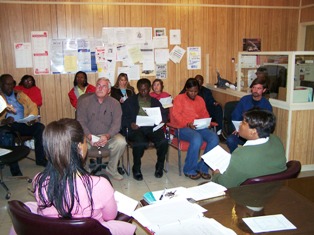Unit 5 Introduction
Reading: Chapter 5 in Macionis, pp. 119 - 143
Unit 5 builds on the concept of social structure that was introduced in Chapter 4, focusing on the characteristics of groups and organizations. In unit 5, we study different types of groups as well as common aspects that contribute to group structure. We illustrate group characeristics by looking in detail at formal organizations, or rationally structured organizations that sociologists refer to as bureaucracies. We look at the characteristics that define formal organizations and some of the benefits and costs of rational organizations. We also consider some of the challenges produced as formal organizations evolve.
 Fig. 5-1: Town Meeting, Rosedale, Mississippi |
Unit 5 introduces one of the salient lessons in sociology: the distinction between primary and secondary attachments, and different types of groups that result from these contrasting types of interaction. The distinction between these two basic orientations has occupied many social theorists, and we will return to variations of this distinction between primary and secondary groups throughout the semester.
In unit 5 you will come to appreciate some of the unique characteristics of "modern" societies, through the study of bureaucratic organizations. These highly rational, formal organizations allow humans to produce material goods at levels that are much greater than any time in history, but they do so at a human cost. This is because they often are dehumanizing, reducing people with complex and interesting personalities down to one or two specific statuses, and people only relate to each other based on those limited statuses. Many people find this alienating and react negatively to bureaucratic situations.
GO TO WEEK 5 GOALS AND OBJECTIVES>>>
<<<GO TO WEEK 1 THRU 5 SCHEDULE